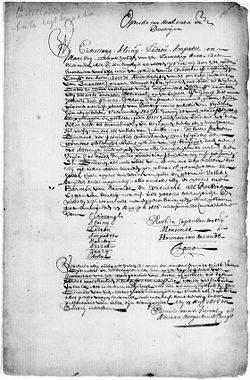Treaty of Butre
| Dedication of Upper Ahanta and Butre | |
|---|---|

Copy of the Treaty of Butre (1656) between the Netherlands and Ahanta (Gold Coast). Nationaal Archief, coll. OWIC 12.
|
|
| Type | Creation of a protectorate |
| Signed | 27 August 1656 |
| Location | Butre, Ahanta (now Ghana) |
| Effective | 27 August 1656 |
| Expiration | 6 April 1872 |
| Signatories | chiefs of Ahanta, director general of the Dutch Gold Coast |
| Parties | States General of the Netherlands, Dutch West India Company, government of Butre and Upper Ahanta |
| Language | Dutch |
|
|
|
The Treaty of Butre between the Netherlands and Ahanta was signed at Butre (historical spelling: Boutry), Dutch Gold Coast on 27 August 1656. The treaty regulated the jurisdiction of the Netherlands and the Dutch West India Company over the town of Butre and the surrounding country of Upper Ahanta, creating a Dutch protectorate over the area. The treaty lasted until the Dutch departure from the Gold Coast in April 1872.
The country of Ahanta, in what is now the Western Region of the Republic of Ghana, comprised a regional power in the form of a confederacy of chiefdoms which had come in early contact with the European nations settling on the Gold Coast for the purpose of trade.
In the middle of the seventeenth century the Dutch West India Company and the Swedish Africa Company were competitors in the Ahanta area of the Gold Coast. The Dutch had been active in Athana and resident in neighboring Axim since 1642, the Swedish in Butre since 1650. The European powers allied themselves with African states and chiefs in order to gain a sustainable dominance in the area.
In their efforts to dislodge the Swedish from Butre, the Dutch struck up different tactical alliances with the chiefdoms of Ahanta and the state of Encasser, a political entity of which little is known.
After the Dutch had driven the Swedish out of Butre, the director general of the Dutch West India Company, with headquarters in St. George d'Elmina in the central Gold Coast, decided that it would be beneficial to negotiate a treaty with the local political leadership in order to establish a peaceful long-term relationship. The Ahanta leaders found it equally beneficial to enter into such an agreement. The 1656 treaty signalled the definitive switch in European jurisdiction in the area until 1872.
The treaty and the terms of the protectorate turned out to be very stable, most likely in part because the Dutch never had the intention to interfere in the affairs of the Ahanta states. That is, except for the town of Butre, where they built a fort (Fort Batenstein). The treaty could be interpreted as a treaty of friendship and cooperation, rather than as a treaty establishing a Dutch protectorate. The Dutch worked in close cooperation with the local chief, who was also second in line in the political leadership of what became known as the Kingdom of Ahanta and had its capital at the nearby seaside town of Busua.
...
Wikipedia
